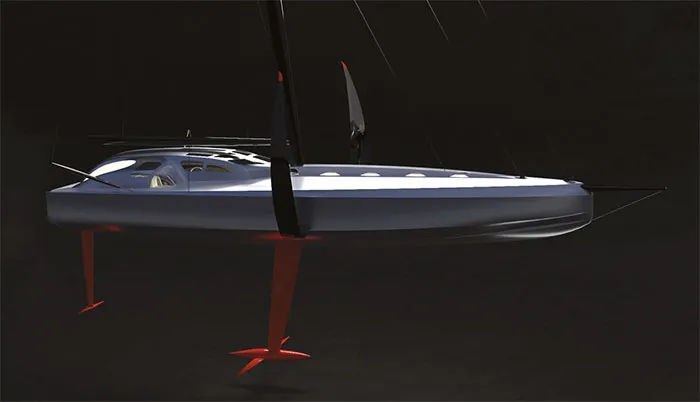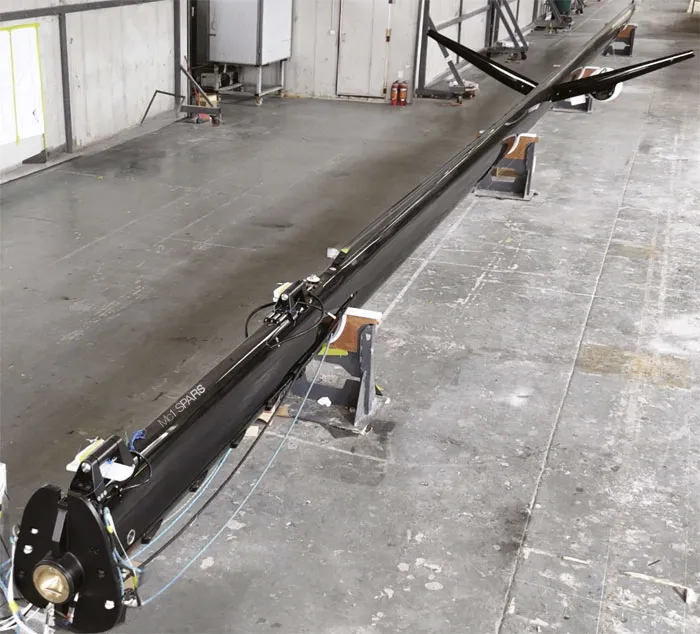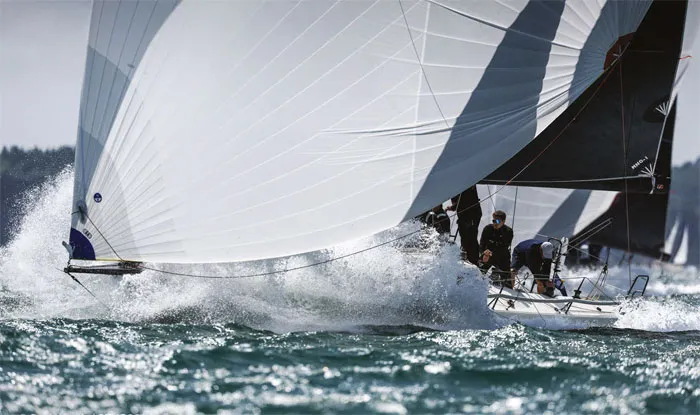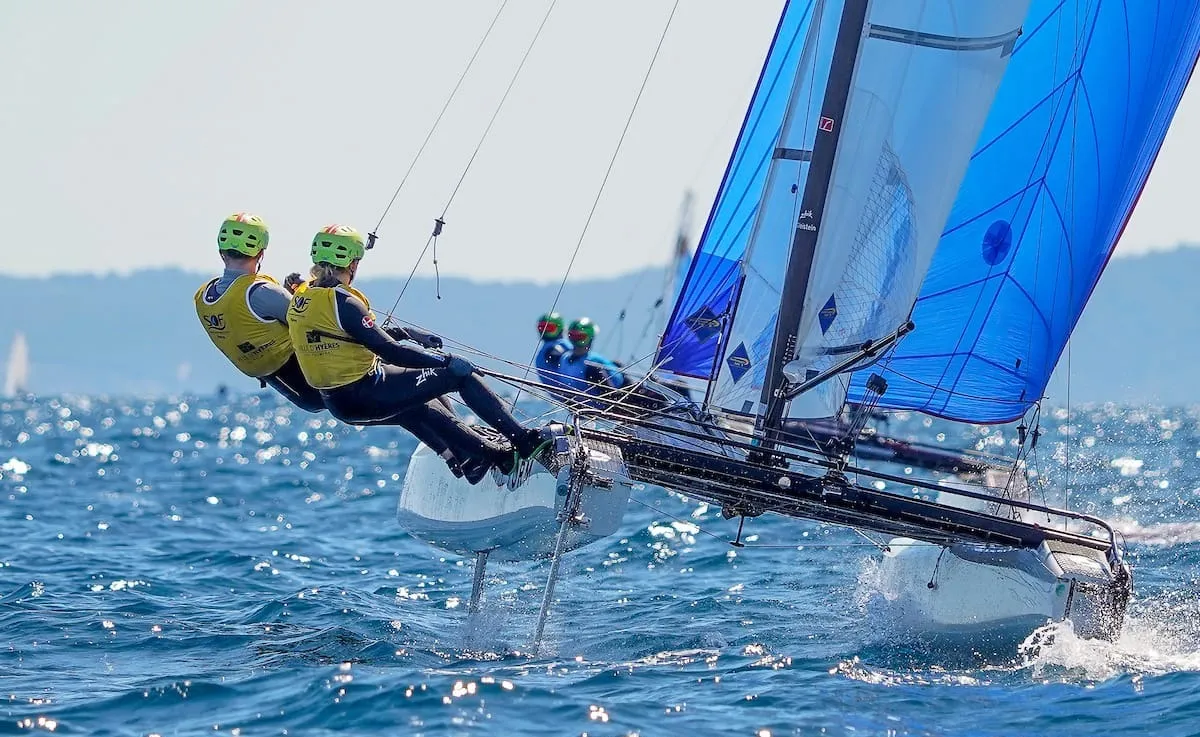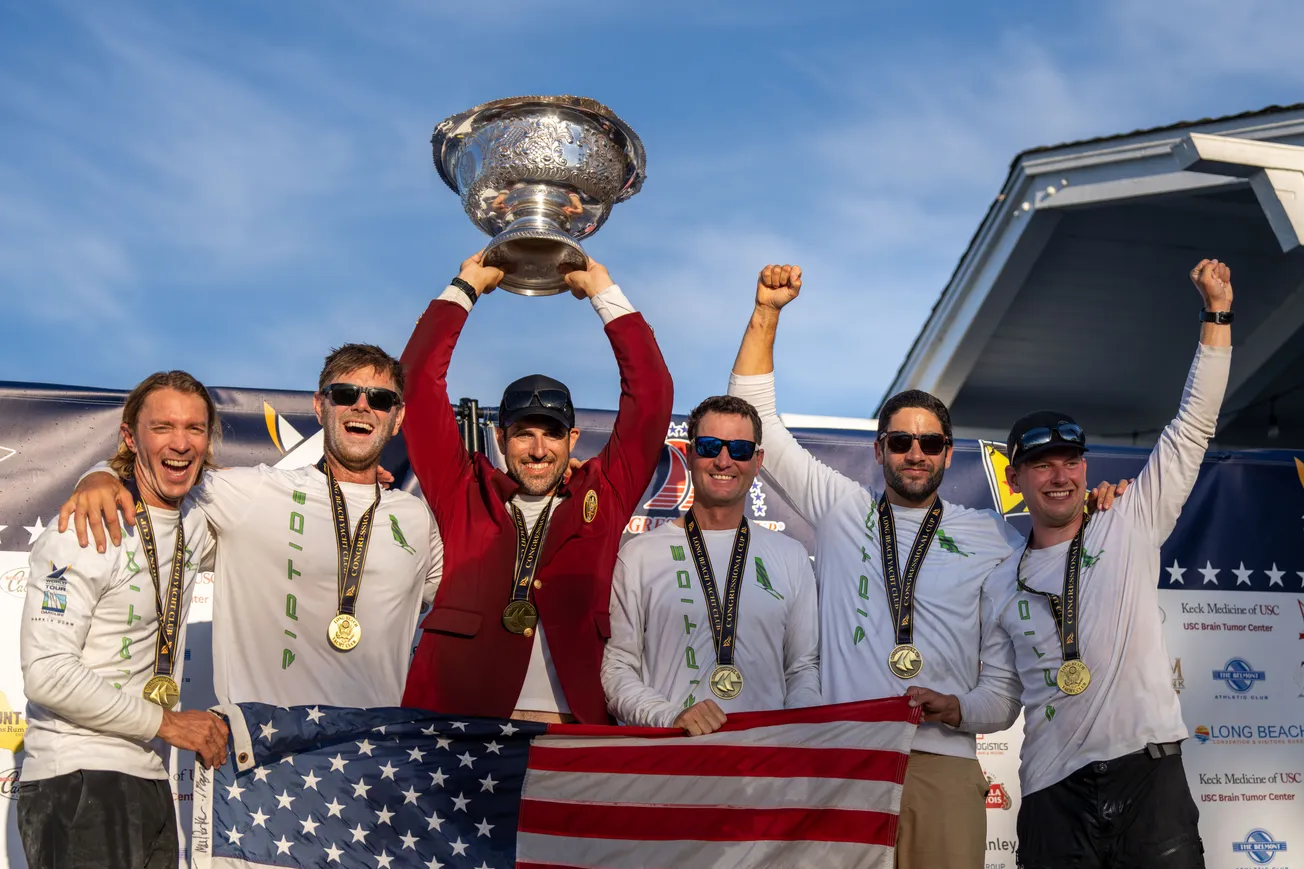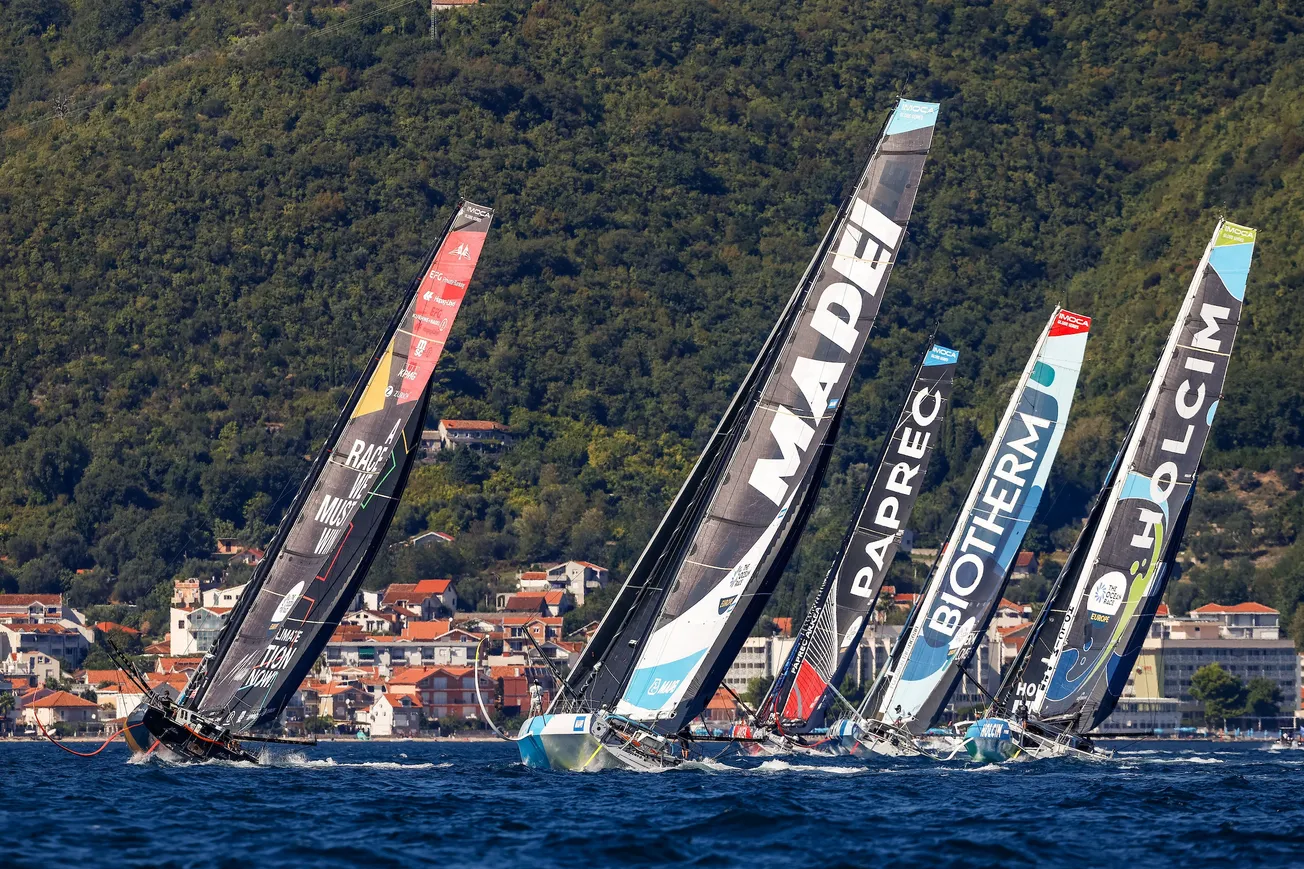
On Saturday afternoons there is an almost rarefied atmosphere in the ship-repair area of the commercial port of Genoa. During the week these dry docks and shipyards are teeming with workers, resonant with the sound of metalwork and other industrial activity. After passing the checkpoint to enter the port area, I find myself between deserted cranes and warehouses.

In an unreal silence I reach a forecourt where I see a Class40 on its cradle. I have arrived at Sangiorgio Marine where an exciting project to build a new, fully foiling 45ft ocean racing monohull – with the ambition to launch a new offshore one design class – is about to get under way.
This young company is already a rising star in the raceboat construction industry. Its founder and CEO, Edoardo Bianchi, has an impressive CV with more than 10 years of recent experience at Persico Marine as manager and director of America’s Cup projects for both Land Rover BAR and Luna Rossa.

Bianchi has also represented Italy in the Tornado class at the Athens and Beijing Olympic Games and, as readers of Seahorse with long memories might recall, back in 2010 he successfully fitted a set of foils to his Tornado catamaran White Dragon as part of the thesis for his marine engineering degree. Thus Bianchi combines the skills of a top class sailor, a pioneering foiling engineer and a technical leader for grand prix sailing projects.
Sangiorgio Marine struck gold with the very first boat they built. That was Alla Grande Pirelli, the first in a series of Class40s built to Gianluca Guelfi’s Musa 40 design, which Ambrogio Beccaria sailed to victory in the 2023 Transat Jacques Vabre after finishing second in Class40 to Yoann Richomme in the previous year’s Route du Rhum.
Gianluca Guelfi explains his design
The concept of the Metis 45 was born from an extensive research project on the dynamic stability of foiling yachts. When a boat goes from displacement mode to full foiling, its dynamic behaviour changes drastically. Traditional VPP methods or CFD hydrodynamic simulations are no longer sufficient to study its performance. Instead, it is necessary to analyse how these forces vary over time, specifically by studying their derivatives across the six degrees of freedom.
We developed software called Manta, designed to simulate various foil configurations, with the goal of achieving the most stable flight possible.

There is a trade-off between stability and efficiency in the foil configuration of a full-foiling boat. In inshore sailing, as seen in Moths, AC75s, or TF35s, a less stable but more efficient foil setup can be accepted, relying on a highly reactive crew and/or automatic control systems.
In offshore racing, especially with a reduced crew, the objective is to avoid complex control systems and minimise the need for continuous adjustments. As of today, offshore full foiling is still in its early stages, and the challenge in the coming years will be to design offshore boats capable of stable foiling without relying on external control systems.
Our design employs a pair of adjustable foils connected to the keel bulb, drawing inspiration from the foil configurations of Ultim-class oceanic trimarans, which are currently the only vessels capable of stable foiling on long ocean passages.
The Metis 45 is the result of all this research – a concept that aims to demonstrate the feasibility of a new generation of offshore monohulls, relatively simple in design, with costs and dimensions that align perfectly with the current fleet of offshore racing yachts.
Sangiorgio Marine is the yacht racing division of a major league shipbuilding group. Its parent company San Giorgio del Porto is part of Genova Industrie Navali, whose interests in both the shipping and yachting sectors range from refitting and repairs to new construction and design. The group’s involvement in yacht racing through Sangiorgio Marine is strategic, enabling a two-way transfer of know-how between a long-established leader in the ship repair industry and the new world of hi-tech raceboats.
In particular, Sangiorgio Marine’s cutting-edge work in carbon composite boat construction could well be applied in other industry sectors. This has already been the case with another company previously owned by Bianchi, at Faenza in Italy’s so-called “motor valley”, where technology developed for yachting is now being applied to motorsport.

The construction of the first Musa 40 for Pirelli and Beccaria was the embryo around which Sangiorgio Marine began its rapid growth, working towards the declared goal of becoming a leading builder of Imoca 60 class yachts. While steadily expanding in terms of space, the boatyard has also grown from three to almost 50 employees in just three years, recruiting many young men and women. The average age of its employees is just 37.

In addition to its Musa 40s, Sangiorgio Marine has built two high-speed motor vessels (HSVs) for Bluegame which were the chase boats for American Magic and the French Orient Express Racing Team in the 37th America's Cup. Its production facilities include a 9m x 3m autoclave, a modular oven that can be expanded as required, a clean room with a refrigerator for prepreg materials, cutting plotters and a milling area.
As I enter the yard’s huge covered area, which has 4,000m² of floor space, I see two more Musa 40s under construction and an interesting variety of other boats being refitted. These include a couple of maxi fast cruisers and the DSS foiling Infiniti 46 formerly known as Maverick. I was met here by Cecilia Gallamini, the communications and marketing manager of Sangiorgio Marine, who brought me up to speed with their next offshore raceboat construction project: the foiling Metis 45.
Presented for the first time at the Boot 2025 boat show in Düsseldorf by Bianchi and Guelfi, who designed the Metis 45 with his partner Fabio D’Angeli, the first renderings of the boat received a great deal of interest.

The Metis 45 is conceived as a one design class but it is also suitable for solo sailors and teams who want to compete in existing offshore events with a full-foiling boat. Its primary purpose is to allow sailors to gain significant experience in offshore foiling, with performance similar to that of an IMOCA, before moving on to higher classes. However, it could also be a super-fun boat for owners and teams who simply want to sail the ocean on foils, or a competitive offshore racer in its own right.

Unlike an IMOCA (which cannot currently be defined as a full-foiling boat as it does not have elevators on the rudders), the Metis 45 is equipped with an elevator on the blade of its single rudder.
Constructed entirely in carbon fibre composite materials, the Metis 45 has waterlines inspired by planing powerboats, with flared sections to improve the transition from wave to foil and to reduce deceleration in rough seas. The boat’s beam is relatively narrow because the righting moment is generated by lift from the immersed foil to leeward rather than by form stability.
The keel is fixed, not canting, to reduce the complexity and cost of the boat’s hydraulics. However, it has an innovative system of adjustable foils connected to the bulb, which is inspired by the “manta” of the Ultim-class ocean trimarans. By distributing lift between the lateral foils and the central manta, this setup is designed to enable the Metis 45 to sail in full-foiling mode with great stability and without the need for complex electronic flight management.

Much of the experience gained by Sangiorgio Marine and Guelfi D'Angeli with the Musa 40 has gone into this highly original and innovative yacht, so much so that the idea was initially to make a foiling version of their winning Class40 design.
However, it was decided instead to start again from first principles with a completely new and larger boat for several reasons: at least 5ft more length allows better management of the foil systems and there was also no risk of "polluting" the Class40 with innovations that would have been contrary to the spirit of this class, which is characterised by simplicity. Bianchi might have preferred a new Open 50, but the risk of overspending would have been too great: 45ft LOA (13.7m) is certainly a good compromise between all the requirements.
The configuration on board is for a crew of two or four, with room for a fifth crew member to act as an onboard reporter. The boat has a modern and safe deck plan with a large coachroof to enclose the cockpit with large windows to enable the crew to keep a good lookout.
Bianchi's desire is to put the sailor and his skills back in the spotlight, rather than technology. For example, he is studying the use of an autopilot with limited electronic sophistication to encourage a return to the helm, which runs contrary to the current trend of relying heavily on extremely sophisticated autopilots, leaving the sailors (especially solo sailors) free to concentrate on navigational strategy.
The Metis 45 will therefore be equipped with a twin wheel setup, enabling the helmsman to see around and beyond the large cockpit enclosure, within which the trimmers and navigation stations will remain. This is a necessary protection, not just for comfort but also for safety, given the high speeds the Metis 45 will be able to reach.

‘The idea came to me during the Rolex Fastnet Race,’ Bianchi explains, ‘when I saw the enthusiasm at the finish line of Francesca Clapcich. She is a friend with whom we had celebrated two months earlier in Genoa when she won The Ocean Race with 11th Hour Racing. I was on board Andrea Fornaro's Musa 40 Influence, she was on IBSA with Alberto Bona, and she was particularly happy to be back on a more traditional boat.’

In terms of management, this boat will be much closer to a Class40 than to an IMOCA, with two shore team members, but one could be enough if the skipper wanted to devote himself to the boat when ashore.
The Metis 45 immediately aroused a great deal of interest when the concept was announced. Sangiorgio Marine is now in negotiations to build the first of what Bianchi and his team hope will be a one design fleet that will compete in top tier offshore regattas such as the Rolex Fastnet Race, the Rolex Middle Sea Race and the RORC Caribbean 600.
In this respect it would be a great help if the classic trans-ocean passage races, such as the Transat Jacques Vabre for instance, were willing to welcome a newborn Metis 45 One Design class, perhaps starting as an Open class until a good number of boats are in the fleet.
Get all areas access to Yacht Racing Life with a Full Membership free 30-day trial. There's no obligation and you can cancel at anytime.


